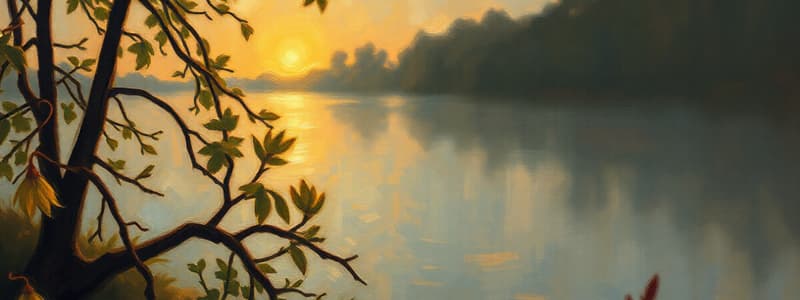Podcast
Questions and Answers
What is the main advantage of using DNG format over proprietary raw files?
What is the main advantage of using DNG format over proprietary raw files?
- It retains less image data than Camera Raw.
- It is only usable in Adobe software.
- It holds more colors per pixel.
- It offers better compatibility and smaller file size. (correct)
How does the bit depth of an image affect its quality?
How does the bit depth of an image affect its quality?
- Higher bit depth allows for a greater number of colors or shades. (correct)
- Higher bit depth results in smaller file sizes.
- Bit depth does not affect image quality.
- Higher bit depth decreases color quality.
What does a histogram represent in image editing?
What does a histogram represent in image editing?
- The dynamic range of the image.
- The color depth of the image.
- The file size of an image.
- The tonal range from shadows to highlights. (correct)
Which color space is best suited for high-quality printing?
Which color space is best suited for high-quality printing?
What is the main function of the Library module in Lightroom?
What is the main function of the Library module in Lightroom?
What does a higher dynamic range in an image indicate?
What does a higher dynamic range in an image indicate?
What adjustment can be made using Lightroom's masking tools?
What adjustment can be made using Lightroom's masking tools?
Which of the following images would typically be saved at 300 dpi?
Which of the following images would typically be saved at 300 dpi?
What does the Black Point/White Point triangle indicator help to prevent?
What does the Black Point/White Point triangle indicator help to prevent?
What is the primary difference between Saturation and Vibrance in Lightroom?
What is the primary difference between Saturation and Vibrance in Lightroom?
What does HSL stand for in Lightroom?
What does HSL stand for in Lightroom?
What happens when using the Masking Slider for sharpening in Lightroom?
What happens when using the Masking Slider for sharpening in Lightroom?
Which tool allows for local adjustments in Lightroom?
Which tool allows for local adjustments in Lightroom?
How many shades per channel does 16-bit color depth support?
How many shades per channel does 16-bit color depth support?
What does the term Chromatic Aberration refer to in image processing?
What does the term Chromatic Aberration refer to in image processing?
What can you accomplish by painting on a Layer Mask in Photoshop?
What can you accomplish by painting on a Layer Mask in Photoshop?
Flashcards are hidden until you start studying
Study Notes
Camera Raw and DNG
- Camera Raw is a file format for raw, unprocessed image data directly from a camera sensor.
- DNG is a standardized, open-source raw file format by Adobe, offering better compatibility and smaller file size compared to proprietary raw formats.
Bits and Bytes
- Bits determine the number of colors or shades per pixel, contributing to image quality and color depth.
- Bytes are units of data storage, with 1 byte equaling 8 bits.
- Higher bit depth results in larger file sizes.
Dynamic Range
- Dynamic range refers to the difference between the lightest and darkest parts of an image.
- Higher dynamic range means more detail in shadows and highlights.
- Dynamic range influences exposure and tone control.
Color Theory: CMYK vs. RGB
- CMYK stands for Cyan, Magenta, Yellow, and Black, used for printing.
- RGB stands for Red, Green, Blue, used for digital devices and screens.
- CMYK uses subtractive color mixing, subtracting light to create colors while RGB uses additive color mixing, adding light to create colors.
RAW vs. DNG for Image Data
- RAW is a proprietary uncompressed image format retaining maximum detail.
- DNG is an open-source compressed version of RAW, offering more versatility across different software programs.
Lightroom Software: Importing and Organisation
- Import images into Lightroom ensuring correct file type and organized folders.
- Metadata can be added to images during import.
- Apply presets during import for quick adjustments.
Lightroom Masking Tools
- Masking tools in Lightroom allow selective adjustments for specific areas of an image.
- Examples include Gradient, Radial Filters, and Adjustment Brush.
- Use masking for targeted exposure, saturation, sharpness, or other adjustments.
Camera Raw Adjustments in Lightroom's Develop Module
- Adjust white balance, exposure, contrast, clarity, and other basic settings within the Develop module.
Histograms: Visual Representation of Image Tone
- A histogram represents the tonal range of an image visually.
- The scale ranges from 0 to 255, where 0 is pure black and 255 is pure white.
- Clipping indicates the loss of detail in shadows or highlights.
Color Spaces: AdobeRGB1998, sRGB, and ProPhoto
- sRGB is a standard color space widely used for web and digital media.
- AdobeRGB1998 offers a wider color gamut suitable for high-quality printing.
- ProPhoto offers an even larger color gamut catering to professional-level editing and printing.
Resolution and DPI: 72ppi vs. 300dpi
- 72ppi is the standard for web images, representing lower resolution.
- 300dpi is the standard for printing, ensuring high resolution and quality.
Lightroom Modules: Library and Develop
- The Library module in Lightroom focuses on organizing images, rating, and tagging.
- The Develop module is where edits and adjustments are applied to images.
Histogram Clipping Triangle Indicators in Lightroom
- Black point and white point indicators guide adjustments to avoid clipping.
- Exposure clipping warns about potential loss of image data in highlights or shadows.
Clarity Tool in Lightroom
- The Clarity tool adjusts mid-tone contrast, creating a crisper or softer look for images.
Masking Tools in Lightroom
- Masking tools in Lightroom allow for local adjustments to exposure, color, clarity, etc.
- Some tools include Graduated Filter, Radial Filter, and Adjustment Brush.
Saturation vs. Vibrance
- Saturation uniformly adjusts the intensity of all colors in an image.
- Vibrance selectively boosts colors while preserving skin tones and preventing over-saturation.
Color Mixer: HSL in Lightroom
- HSL refers to Hue, Saturation, and Luminance.
- The Color Pointer allows selecting specific colors for fine-tuning their properties.
Lightroom Collections, Target Collections, and Shortcuts
- Collections are folders for grouping images, facilitating organization.
- Target Collections are default collections for quick sending images.
Chromatic Aberration
- Chromatic aberration manifests as color fringing around high-contrast areas in images.
- It can be corrected using lens correction tools in Lightroom.
Metadata in Lightroom
- Metadata contains information about a photo, including camera settings, date, location, and more.
- This information is stored within the image file.
Sharpening in Lightroom
- The Masking Slider helps apply sharpening only to edges, avoiding noise in smooth areas.
White Balance
- White balance adjusts the color temperature and tint of an image for accurate color representation.
HSL: Hue, Saturation, and Luminance
- Hue controls the color tone.
- Saturation adjusts the color intensity.
- Luminance adjusts the brightness of specific colors.
Luminosity Range and Masks
- Luminosity range refers to the lightness variation in an image.
- Luminosity masks target edits based on brightness levels.
Photoshop: Layers and Layer Opacity
- Layers in Photoshop allow stacking images or effects non-destructively.
- Layer Opacity controls the transparency of layers.
Layer Masks in Photoshop
- Layer masks define visibility of layers by painting with black (hide) or white (reveal).
Adjustment Layer Masks in Photoshop
- Adjustment layer masks apply adjustments like brightness and contrast selectively to specific parts of an image.
Painting on Masks with White/Black Brushes
- White brushes reveal parts of the mask, while black brushes hide them.
- Opacity and softness control precision during painting.
8-bit vs. 16-bit Images
- 8-bit images allow 256 shades per color channel.
- 16-bit images offer 65,536 shades per channel, beneficial for detailed editing.
Transformation Tool and Shortcut
- The Transformation Tool enables scaling, rotating, and skewing images.
- The shortcut for this tool is Ctrl/Cmd + T.
Studying That Suits You
Use AI to generate personalized quizzes and flashcards to suit your learning preferences.




